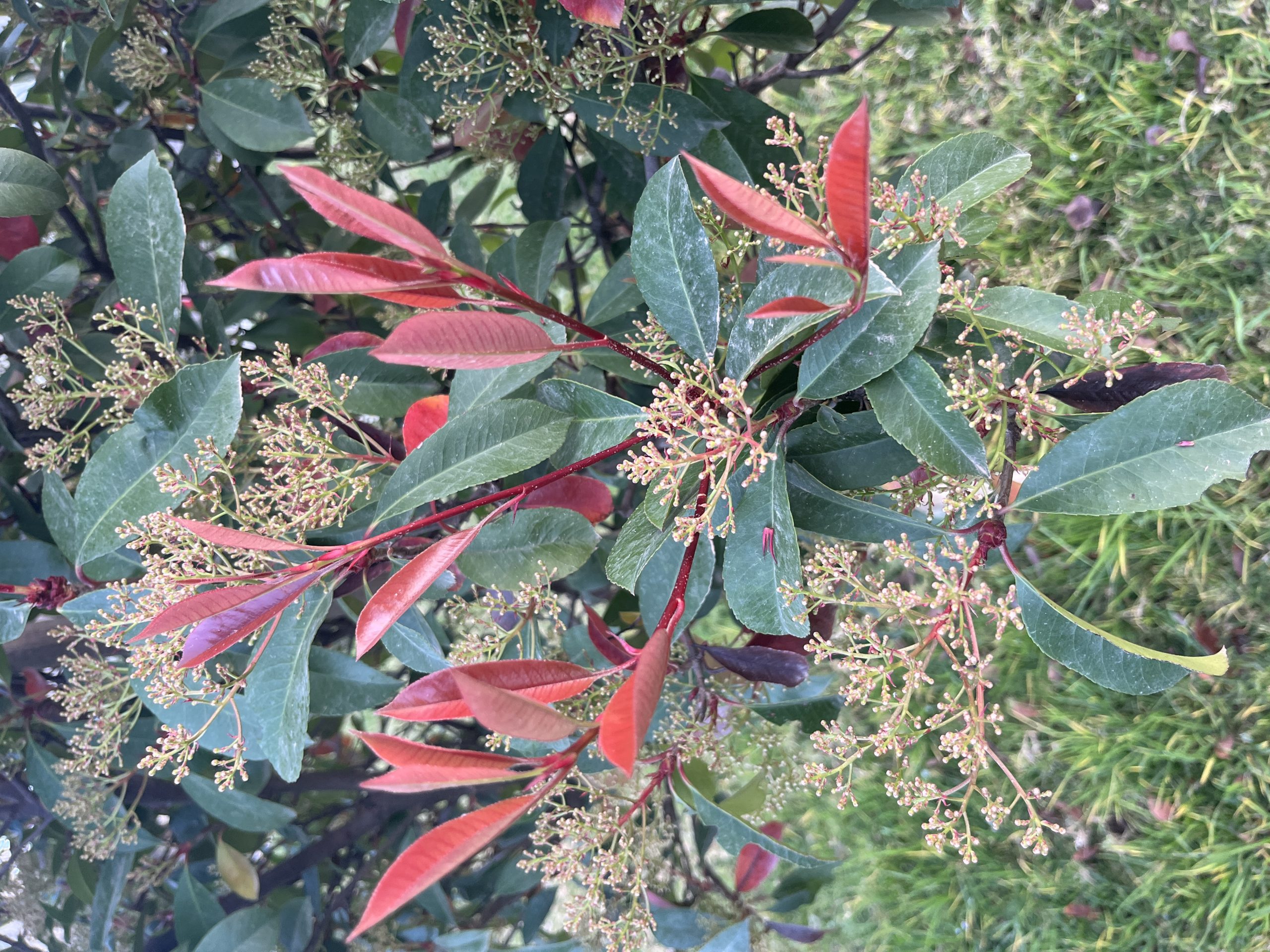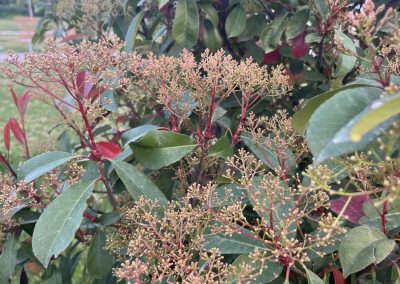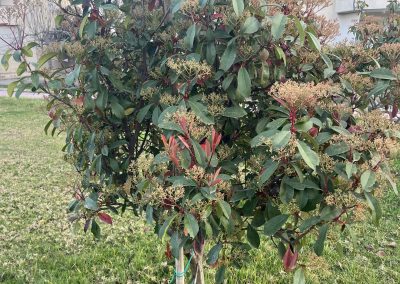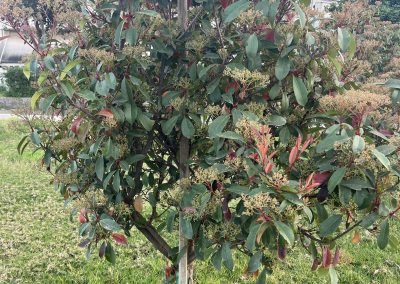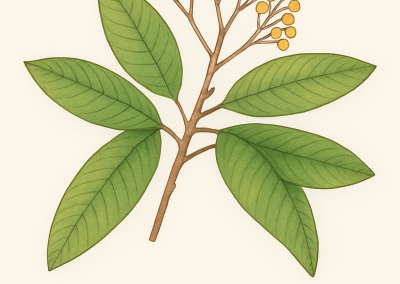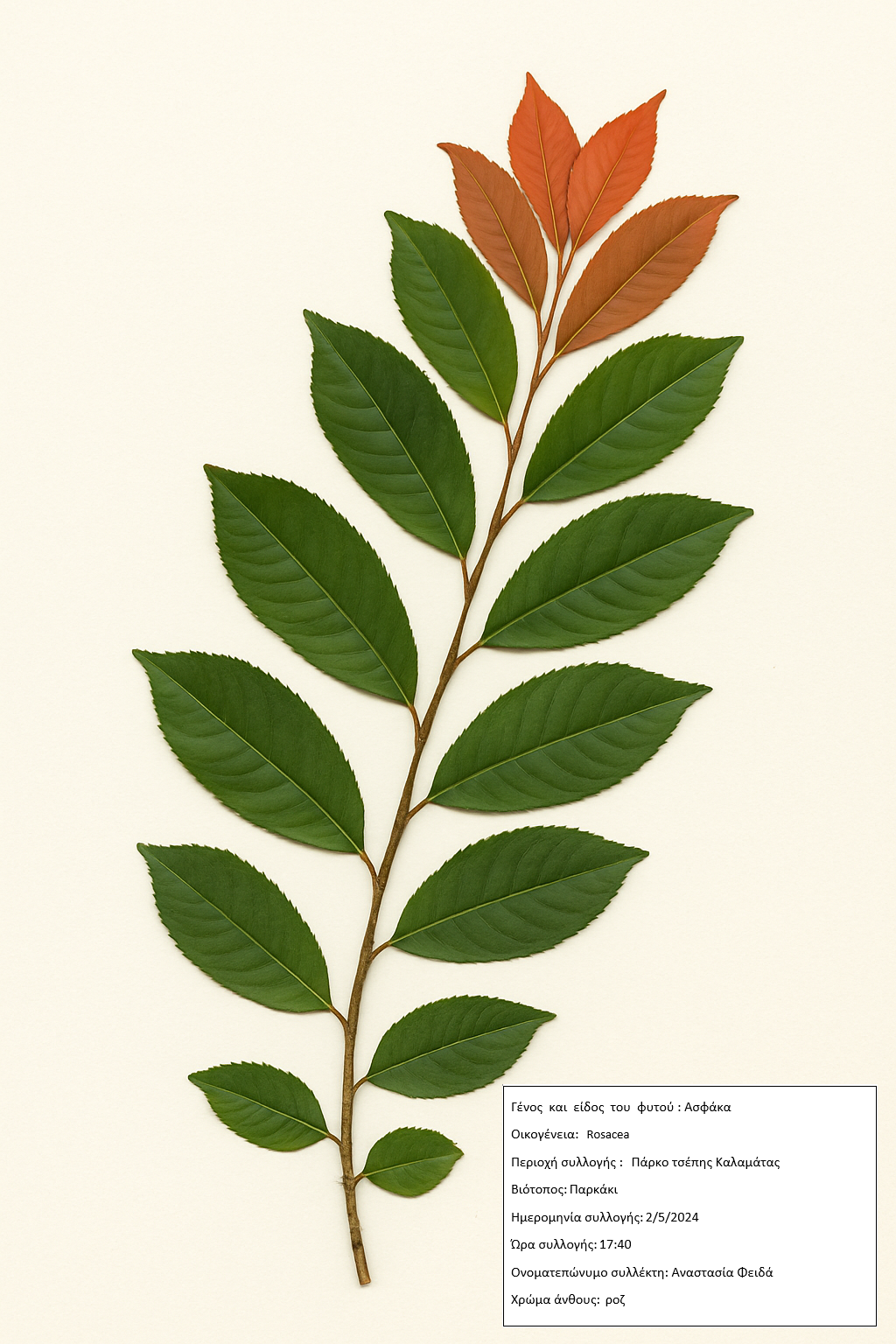Photinia serratifolia
Scientific description
Scientific name: Photinia serratifolia
Kingdom: Plantae
Clade: Tracheophytes, Angiosperms, Eudicots, Rosales
Family: Rosaceae
Genus: Photinia
Species: Photinia serratifolia
Origin:
Commonly called Taiwanese or Chinese photinia, it is a flowering shrub or tree of the family Rosaceae, found in mixed forests of China, Taiwan, Japan, the Philippines, Indonesia, and India.
Description:
Usually grows 4–6 m tall, sometimes up to 12 m. Leaves are toxic due to cyanogenic glycosides. Flowers bloom in spring, lasting 1–2 weeks, with a strong odor similar to human sperm. Flowers have bell-shaped sepals divided into five lobes and ~20 stamens. Ovaries contain 2–4 cavities, one egg per cavity. Produces abundant bright red fruits (4–12 mm) each with 1–4 seeds, ripening in autumn and persisting through winter, feeding various bird species.
Propagation:
By seed, but stem cuttings are recommended as the quickest and most reliable method.
Ecology:
Grows in forests, shrubs, and rocky slopes up to 1800 m. Well-adapted to a range of soils, from sandy to clayey, prefers well-drained soils.
Use:
Widely used as a green plant in cities for defensive fences, hide fences, windbreaks, and hedges on road islands due to ease of planting and maintenance.
Επιστημονική ονομασία: Photinia serratifolia
Βασίλειο: Plantae
Clade: Τραχειόφυτα, Αγγειόσπερμα, Eudicots, Ροσίδες
Οικογένεια: Rosaceae
Γένος: Photinia
Είδος: Photinia serratifolia
Καταγωγή:
Κοινώς αποκαλούμενη ταϊβανέζικη ή κινεζική φωτινία, θάμνος ή δέντρο ανθοφόρο της οικογένειας Rosaceae, εντοπίζεται σε μικτά δάση Κίνας, Ταϊβάν, Ιαπωνίας, Φιλιππίνων, Ινδονησίας και Ινδίας.
Περιγραφή:
Αναπτύσσεται συνήθως 4–6 μ., μερικές φορές έως 12 μ. Φύλλα τοξικά λόγω κυανογόνων γλυκοσιδών. Άνθη άνοιξη, διάρκεια 1–2 εβδομάδες, με έντονη οσμή όπως ανθρώπινο σπέρμα. Σέπαλα καμπανοειδή, πέντε λοβοί, περίπου 20 στήμονες. Ωοθήκη με 2–4 κοιλότητες, ένα ωάριο η καθεμία. Παράγει πολλούς φωτεινούς κόκκινους καρπούς (4–12 χλστ.), με 1–4 σπόρους, ωριμάζουν φθινόπωρο και επιβιώνουν χειμώνα, τροφή για πουλιά.
Πολλαπλασιασμός:
Με σπόρο ή προτιμότερα με μοσχεύματα ως ταχύτερη και πιο κατάλληλη μέθοδος.
Οικολογία:
Φύεται σε δάση, θαμνώνες και βραχώδεις πλαγιές έως 1800 μ., προσαρμοσμένο σε ποικιλία εδαφών από αμμώδη έως αργιλώδη, προτιμά καλά στραγγιζόμενα εδάφη.
Χρήση:
Χρησιμοποιείται σε πόλεις ως φυτό πρασίνου: αμυντικοί φράκτες, φράκτες απόκρυψης, ανεμοφράκτες, φράκτες σε νησίδες δρόμων, λόγω ευκολίας φύτευσης και συντήρησης.
Nom scientifique : Photinia serratifolia
Règne : Plantae
Clade : Tracheophytes, Angiospermes, Eudicots, Rosales
Famille : Rosaceae
Genre : Photinia
Espèce : Photinia serratifolia
Origine :
Photinia taïwanais ou chinois, arbuste ou arbre de la famille Rosaceae, présent dans les forêts mixtes de Chine, Taïwan, Japon, Philippines, Indonésie et Inde.
Description :
4–6 m de hauteur, parfois 12 m. Feuilles toxiques (glycosides cyanogènes). Fleurs printanières, 1–2 semaines, forte odeur similaire au sperme humain. Sépales en cloche, 5 lobes, ~20 étamines. Ovaires 2–4 cavités, un ovule chacune. Produits fruits rouges brillants (4–12 mm), 1–4 graines chacun, mûrissent en automne, persistent hiver, nourriture pour oiseaux.
Propagation :
Par graines, mais boutures de tige recommandées pour rapidité et fiabilité.
Écologie :
Forêts, buissons, pentes rocheuses jusqu’à 1800 m. Bien adapté aux sols variés, préfère sols bien drainés.
Utilisation :
Plante verte urbaine : clôtures défensives, occultantes, brise-vent, haies sur îlots routiers, facile à planter et entretenir.
Denumire științifică: Photinia serratifolia
Regn: Plantae
Cladă: Tracheophytes, Angiosperme, Eudicotiledonate, Rosales
Familie: Rosaceae
Gen: Photinia
Specie: Photinia serratifolia
Origine:
Cunoscută ca fotinia taiwaneză sau chineză, arbust sau arbore cu flori din familia Rosaceae, prezentă în pădurile mixte din China, Taiwan, Japonia, Filipine, Indonezia și India.
Descriere:
Crește 4–6 m, uneori până la 12 m. Frunze toxice (glicozide cianogenice). Florile primăvara, 1–2 săptămâni, miros puternic, asemănător spermei umane. Sepale clopot, 5 lobi, ~20 stamine. Ovar cu 2–4 camere, câte un ovul fiecare. Fructe roșii strălucitoare, 4–12 mm, 1–4 semințe, coacere toamnă, persistă iarna, hrană pentru păsări.
Înmulțire:
Prin semințe, recomandat prin butașire pentru rapiditate și fiabilitate.
Ecologie:
Păduri, tufișuri, pante stâncoase, până la 1800 m, bine adaptată la soluri variate, preferă soluri bine drenate.
Utilizare:
Plantă decorativă urbană: garduri vii de protecție, de mascaj, paravane contra vântului, garduri pe insulele din mijlocul drumurilor; ușor de plantat și întreținut.
Creative writing inspired by Photinia serratifolia
Photinia serratifolia — Fotini's Myth
Once upon a time, on the slopes of a lush mountain in ancient Greece, there lived a young woman named Fotini, known for her kindness and radiant spirit. Fotini had the remarkable ability to brighten the hearts of everyone around her, much like the sun dispels the darkness. The people in her village loved her and would invite her to every celebration, believing that her presence brought good fortune and blessings.
One day, Fotini learned that a dear friend, a young poet, had fallen into deep despair. His words had dried up, and his heart was consumed by darkness. Determined to help him, Fotini climbed the mountain and sat beneath a tree, praying to the gods to give her the power to bring light back into his life.
The goddess Demeter, hearing Fotini’s prayers, appeared before her and offered her a gift: a plant with bright, red leaves that shimmered like Fotini’s own inner light. "This plant," said Demeter, "will bring light where there is darkness. Plant it in your friend's garden, and every time he gazes upon its leaves, he will remember the light that lives within him."
Fotini followed the goddess’s instructions and planted the shrub in her friend's garden. Over time, the red leaves of the plant, which came to be known as Photinia, began to glow in the sunlight, and the young poet’s soul was filled once again with inspiration and joy. His sorrow faded, and his creativity returned, as though he had rediscovered the light within himself.
From that day forward, the Photinia became a symbol of light and hope. It was believed that whoever grew this plant would bring light and positive energy into their life, driving away darkness and despair. Its red leaves, like flames of hope, would illuminate the hearts of people, even in their darkest moments.
Thus, the myth of Fotini and the Photinia was born, a plant symbolizing the brightness of the soul and the power of light to conquer darkness, reminding everyone that even in the hardest of times, the light of hope always shines through.


